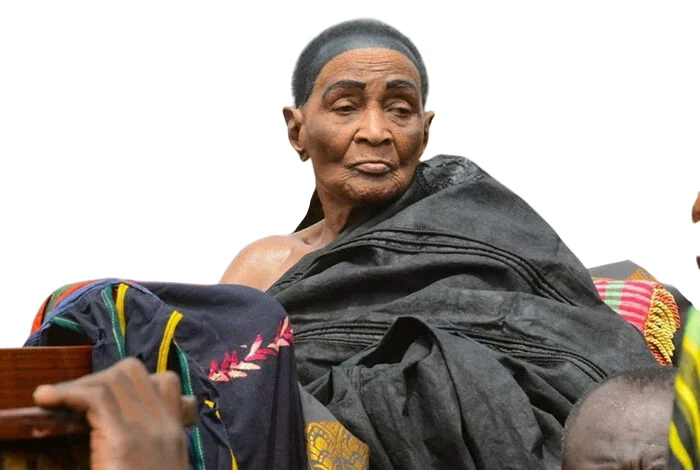By Admin1
Copyright ghanaiantimes

In the pre-dawn darkness of Monday morning, traditional priests and priestesses draped in mourning cloth gathered at Manhyia Palace to pour libations to the ancestors and begin the sacred “Dote Yie” funeral rites of the late Queen mother, Nana Konadu Yiadom III.
From across Asanteman they came—spiritual custodians, some carrying ancient calabashes filled with schnapps, their voices rising in solemn incantations that seemed to pierce the veil between worlds.
The libations flowed onto sacred ground as they called upon ancestral spirits to receive their departed matriarch and guide her home.
Dignitaries, traditional leaders, and ordinary citizens from across the country gathered to pay their last respects to the revered queen mother, whose passing has left a deep void in the Ashanti Kingdom.
It was a scene of ancient cere-monies—the hypnotic rhythm of talking drums that spoke in lan-guages older than written history, ritual dancing that told stories of transition and transcendence, and spiritual invocations that would not merely bury a queen mother, but guide her spirit through its final transformation while uniting an entire kingdom in profound grief.
As the first rays of sunlight broke through the morning mist, the palace grounds was thrown into a sea of red and black—the sacred colours of Asante mourn-ing.
The sight was both breath-tak-ing and heart-wrenching: thou-sands upon thousands of people, from weathered market vendors to distinguished university profes-sors in flowing traditional dress, from elderly chiefs leaning on or-nate walking sticks to wide-eyed schoolchildren experiencing their first royal funeral—all bound together in their shared sense of irreplaceable loss.
The ceremonial splendor of the “Dote Yie” funeral rites reveals the intricate tapestry of Asante culture in all its magnifi-cent complexity.
Paramount chiefs arrived in breath-taking mourning regalia, catching every ray as they paid homage in precisely choreo-graphed sequences.
Perhaps no moment captured the raw spiritual intensity better than when Nana Kwaku Bons-am, Ghana’s most renowned traditionalist, made his dramatic entrance.
Adorned in full ceremonial attire and surrounded by an aura of mystical energy, his powerful ritual dancing drew mesmerized crowds who understood they were witnessing something sacred and unrepeatable.
“This transcends mere fu-neral rites—we are facilitating a profound spiritual transition,” he declared to gathered media, sweat glistening on his brow from his ceremonial exertions. “The ancestors called me here. I could not refuse.”
Throughout the sprawling palace courtyards, mourners wept without shame as traditional dirg-es—some centuries old—echoed off with the haunting melodies intertwined with the rhythm of ceremonial drums, creating a sound that seemed to open doorways between the earthly and spiritual realms.
The queue of people waiting to pay final respects to their beloved queen mother stretched beyond the palace gates and wound through Kumasi’s streets like a river of grief.
At the ceremony’s heart sat Otumfuo Osei Tutu II, the Asantehene, receiving endless streams of homage with the dignified composure expected of Ghana’s most revered traditional ruler.
Yet those who knew him well could see the weight of personal loss behind his regal bearing—the sight of a brother mourning his “guiding light” reminded all present that grief recognises no throne, no crown, no earthly power.
Palace sources revealed that the normally unflappable king had struggled privately with waves of emotion throughout the pro-ceedings, finding strength in the overwhelming outpouring of love from his subjects who had also lost their mother.
As the week builds toward Thursday’s climactic grand finale, the true measure of the queen mother’s influence becomes un-deniably clear.
The entire Kumasi Metrop-olis—Ghana’s bustling sec-ond-largest city—would volun-tarily cease all activity.
Schools would empty, banks would lock their doors, markets would fall silent, and businesses would shutter their windows, not by government mandate but through collective reverence for a life that touched every corner of society.
“This unprecedented shut-down allows every resident to participate fully in these sacred ceremonies without distraction,” explained Nana Effah Apenteng, Paramount Chief of Bompata and Chairman of the elaborate funeral planning committee. “It is our gift to her memory.”
Most remarkably, residents would observe a complete indoor curfew from 7 PM Thursday until 4 AM Friday—a “sacred period” when spiritual tradition holds that the queen mother’s essence will make its final journey to join the ancestors.
In a poignant revelation on August 12, the Asantehene shared that the Queen Mother had been remarkably active on the morning of her final day, attending to her duties with characteristic vigor before her sudden departure in the afternoon.
Her passing came just a day after the nation was plunged into mourning following a tragic mili-tary helicopter crash that claimed the lives of eight high-ranking government officials—an unprec-edented moment of collective sorrow.
Born in 1927 at the sacred Benyaade Shrine in Merdan, Kwadaso, Nana Ama Konadu was the daughter of Nana Afia Kobi Serwaa Ampem II, Asantehemaa from 1977 to 2016, and Opanin Kofi Fofie, a respected carpenter from Besease near Atimatim.
She ascended the stool on February 6, 2016, becoming the 14th Asantehemaa. Her eight-year reign was marked by a graceful fusion of ancient tradition and modern leadership, earning her admiration across generations.
FROM KINGSLEY E.HOPE, KUMASI
🔗 Follow Ghanaian Times WhatsApp Channel today. https://whatsapp.com/channel/0029VbAjG7g3gvWajUAEX12Q🌍 Trusted News. Real Stories. Anytime, Anywhere.



